Impact of groundwater levels and waterlogging on cultivation factors
Abstract¶
Many areas worldwide are looking into rewetting natural areas, with consequences for the surrounding agricultural land. Rising groundwater levels are linked to excess moisture in the root zone. Direct negative effects of excess soil moisture include respiration reduction and damage of roots due to oxygen stress, with subsequent yield decline. Some perennial grasses have high tolerance to saturated conditions compared with arable crops thanks aerenchyma formation (root porosity that allows oxygen transport), or by rooting shallowly. Winter wheat is able to develop physiological adaptations during transient waterlogging, while potatoes and maize are the most sensitive crops, to both too dry and too wet conditions. It is estimated that about 30 % of yield is lost worldwide due to waterlogging in arable crops. Even if yield decrease is not significant, the quality can be highly compromised.
Excess soil moisture also has indirect unfavorable effects on agricultural practices. Decrease of workability and trafficability of the soil are the main concerns for Flemish farmers, since both are essential for optimal planting, plowing and harvesting activities, and are largely limited by soil moisture conditions. Waterlogged soils collapse easily and the soil structure is more vulnerable to damage in the presence of machinery or livestock. Another major concern is sowing and harvesting delays. Lower temperature in wet soils cause delay of the germination process, and harvesting is not possible in soils with low bearing capacity. Harvesting delay in grass compromises its quality as fodder since protein content lowers and fiber content increases. Other indirect effects appear inside the root zone, where anaerobic conditions alter the chemical equilibrium of soil elements, and soil micro-organisms compete with plant roots for the available oxygen and limit the uptake of certain nutrients. Weeds, and bacterial and fungal diseases can be problematic under excess rainfall.
Introduction¶
Rewetting natural areas has consequences for the surrounding agricultural land. During droughts, crops benefit from a shallow water table Zipper et al., 2015, which prevent agricultural drought. Groundwater functions as a buffer replenishing soil moisture through capillary rise, which can contribute up to 50 % of the total evapotranspiration Liu et al., 2016Wu et al., 2015. Deep-rooted crops can access water deep in the soil helping to alleviate drought stress; although, it does not compensate completely for the reduced topsoil water uptake Rasmussen et al., 2020. Shallow groundwater can therefore alleviate drought stress, but probably not compensate it. On the other hand, too wet conditions reduces crop yield due to a lack of oxygen in the root zone, which causes a decrease in crop transpiration Bartholomeus et al., 2008. In addition, excess soil moisture hampers the accessibility of the field for operations such as ploughing, spraying, harvesting, and may increase disease pressure Bakel & Hoving, 2017. The lack of oxygen in (near) saturated soil also affects nutrient cycles and soil biology, which in turn may impact nutrient availability and leaching Irmak & Rathje, 2008. Oxygen stress causes more severe damage in crop physiology than drought stress, and the actual yield is drastically reduced with prolonged waterlogging, and the recovery is less successful Sojka et al., 2005.
Table 1:Minimum gas-filled porosity in the root zone for some crops Wesseling, 1957
Crop | Gas-filled porosity |
|---|---|
Grass | 0.06-0.10 |
Wheat/Oats | 0.10-0.15 |
Barley | 0.15-0.20 |
Sugar beet | 0.15-0.20 |
Table 2:Gas-filled porosity at field capacity (pF 2.7) of various soil types Wesseling, 1957
Soil texture | Gas-filled porosity |
|---|---|
Silt loam | 0.13-0.15 / 0.10 |
Clay | 0.12 - 0.15 / 0.18 / 0.115 |
Loam | 0.11 |
Sandy clay loam | 0.09-0.13 |
With continuously increase of soil moisture in the root zone, soils become saturated. In saturated soils, all the pores are filled with water and the dissolved oxygen in the water is typically around 5 % Moore et al., 1998. In the presence of microbiological activity and persistent excess water, the remaining oxygen is quickly depleted leading to waterlogged conditions. “Too wet” conditions refer therefore to the state from where oxygen stress starts taking place, up to more extreme conditions like waterlogging or flooding.
Effects of too wet conditions in crops, can be classified as direct and indirect according to the methodology incorporated in WaterVision Agriculture Bakel & Hoving, 2017Broeke et al., 2019Broeke et al., 2016. Direct effects are related to reduced crop growth due to insufficient oxygen for plant respiration and occur within the growing season. Indirect effects, also reducing yields, occur in- and outside the growing season and are related to other aspects like workability, sowing delay, crop quality reduction, and vulnerability to pests. Figure 1 gives and overview of these effects. This chapter will therefore describe the direct and indirect effects of too wet conditions due to shallow groundwater levels on crop yield and agricultural practices.
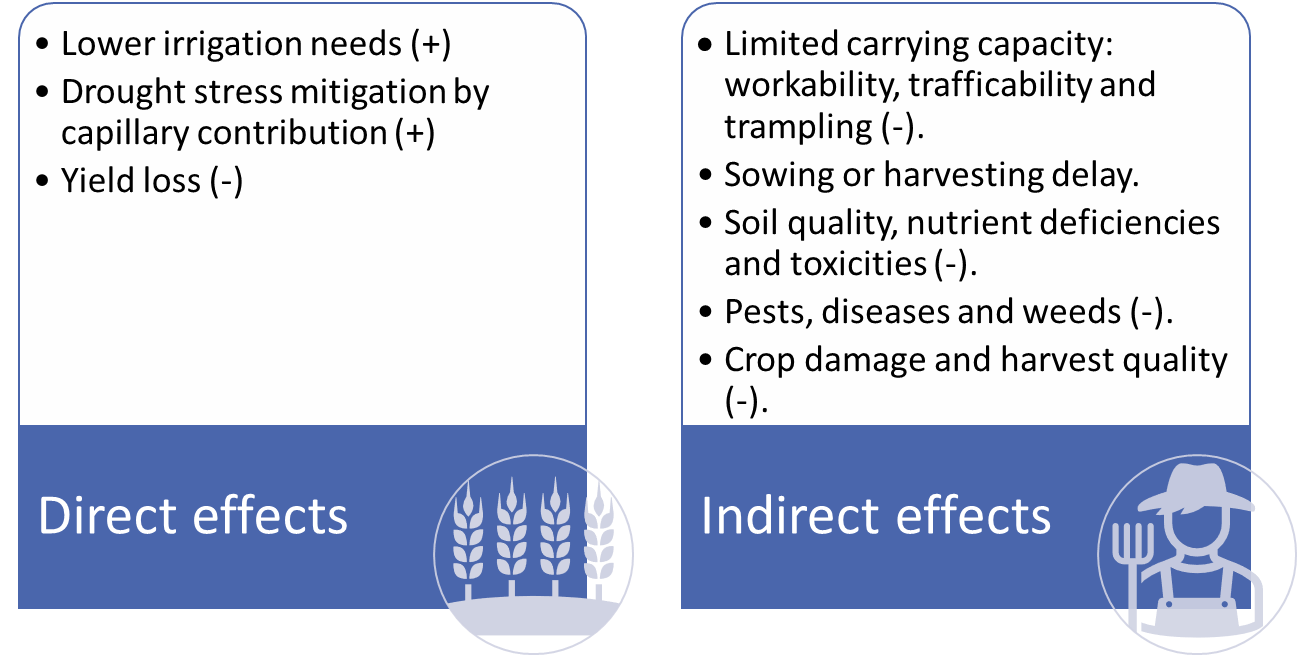
Figure 1:Direct and indirect effects of increasing groundwater levels on agricultural production and field management Broeke et al., 2019Broeke et al., 2016.
Direct effects¶
Oxygen availability in the root zone depends on the physical properties of the soil and microbial activity, which in turn depends on temperature, water and nutrients. Oxygen demand varies according plant physiology, namely crop type, development stage, and root distribution Gliński & Stępniewski, 1985. In suitable conditions, plant roots obtain sufficient oxygen for their respiration directly from the air-filled pores in the soil. However, when soil becomes wetter, air in the soil pores is increasingly replaced by water and energy supply for plant metabolism is reduced. Oxygen deficiency in soil affects plant growth by limiting root respiration Bartholomeus et al., 2008. Root development can be constrained or stop earlier under such conditions, causing a reduction in water and nutrient transport to the upper plant organs, leading to a decrease of biomass and thus, less yield Kahlown et al., 2005Irmak & Rathje, 2008. Shoot response include reduction in leaf chlorophyll content and stomatal closure, which limits transpiration and CO2 transport Manik et al., 2019Bartholomeus et al., 2008Sojka et al., 2005.
Relationship between groundwater and yield¶
Yield reduction at shallow water tables are due to lack of oxygen in the root zone while at lower water tables, yield decrease is caused by water deficiency. The interactions between groundwater and crop yield are mainly controlled by soil texture and weather conditions Feddes, 1971. Soil water retention characteristics regulate infiltration through the root zone and capillary rise Zipper et al., 2015, while yearly variations in weather conditions alter the relationship between groundwater and yield Feddes, 1971. Different experiments performed in The Netherlands from the mid-twentieth century on, attempted to investigate the influence of groundwater levels on crop yield, for different soil textures and crops.
Visser (1959) developed yield-decrease curves as function of the mean water table depth for main soil types in The Netherlands (Figure 2). Yield decrease at a certain water table is strongly correlated with the water retention capacity of the soil. At shallow groundwater levels, soils with good water retention capacity ( e.g. clay soils) show a higher yield reduction because more oxygen stress occur, while at deep water tables, drought stress is smaller due to capillary contribution. The opposite occurs in coarser soil textures like sandy soils. Peat soils are exceptional for their high organic matter content, their physical and hydraulic properties are significantly altered with soil decomposition upon drainage Liu & Lennartz, 2018. In Figure 2, they exhibit a drastic yield decrease with small changes in water table depth. The shape of the curves can however vary considerable with the type of crop and discontinuities in the soil profile.
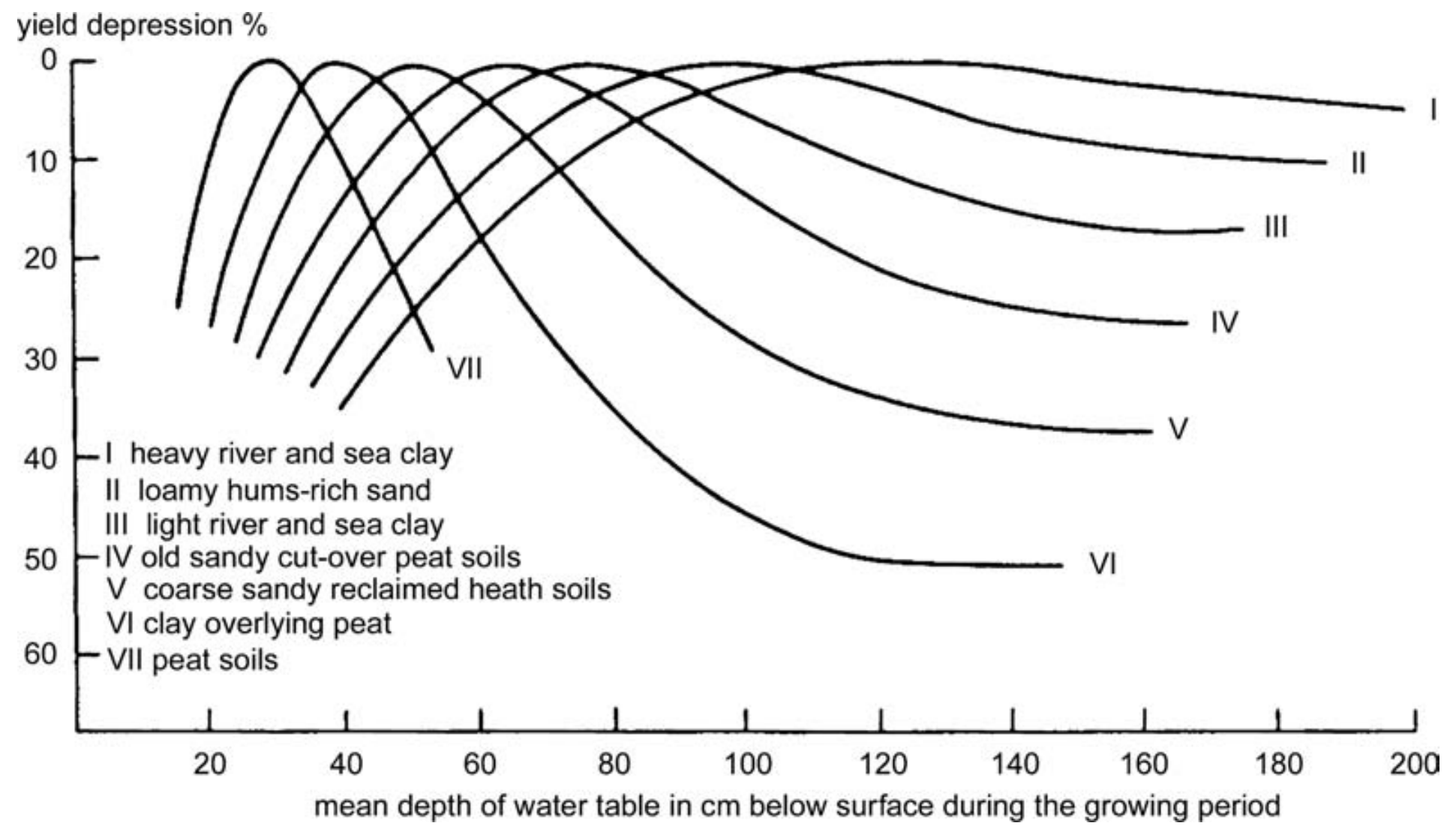
Figure 2:Yield depression as a function of the mean depth of the water table during the growing season for various soil types (after Visser (1958))
Feddes (1971) formulated yield curves in function of groundwater table depth, for five probability of exceedance in clay, sandy loam and clay on sandy loam, for red cabbage, potato and lettuce. Figure 3 presents an adapted version of the relationship between yield and groundwater depth for potatoes for a 90 % probability of yield exceedance (every year). The optimal water table depth, meaning the one that allows the maximum yield, is around 90 cm for clay and clay on sandy loam, and 100 cm for sandy loam. At these water table depths, a fresh yield of about 45 ton ha-1 or more can occur every year. Shallower water levels would lead to oxygen stress and hence yield reduction. These curves differ largely from the ones in Figure 2, especially in the dry section of the curve, because precipitation was not considered, therefore soil water is only provided by capillary rise.
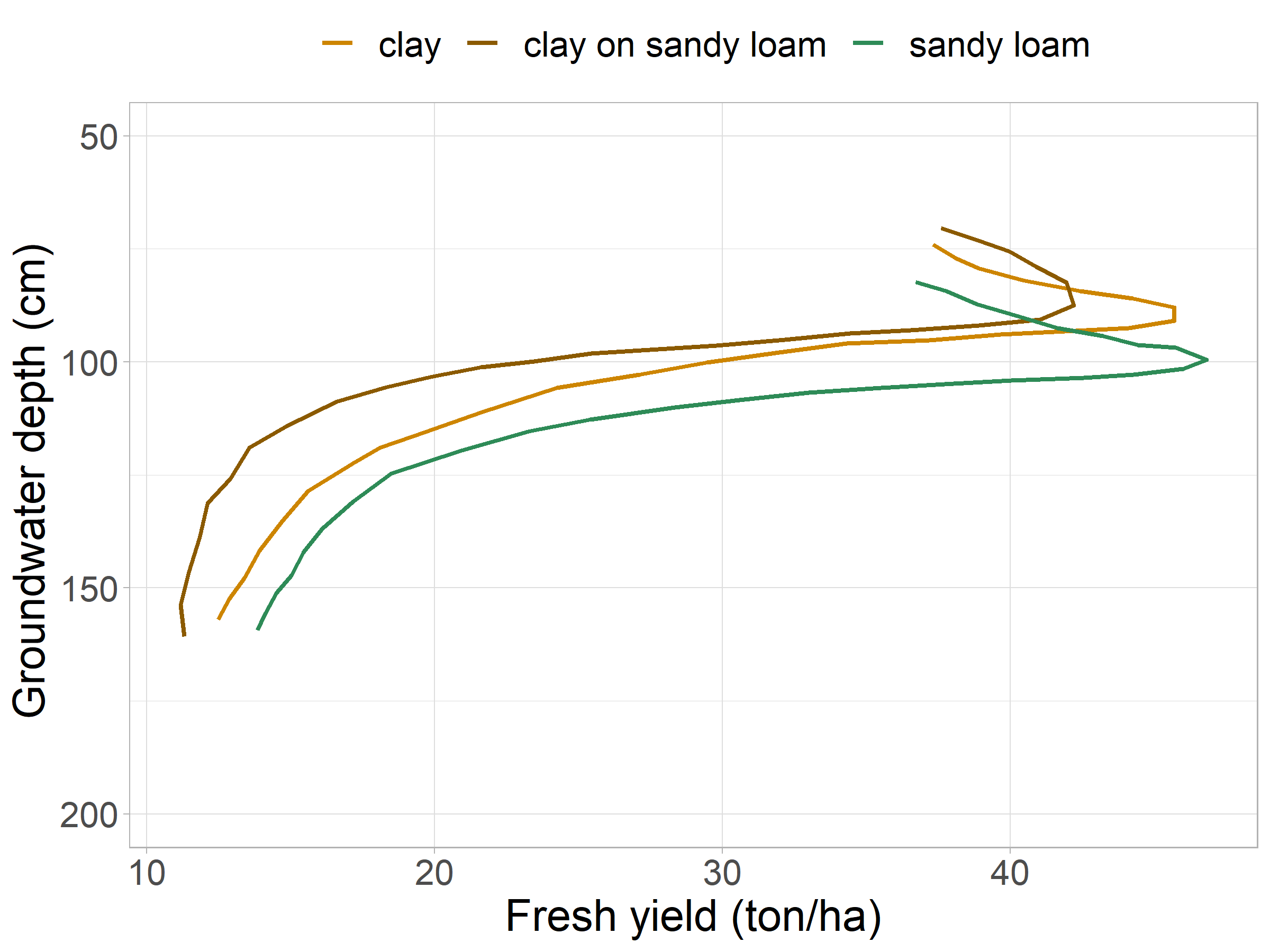
Figure 3:Dependence of potato fresh yield on groundwater table depth over the growing season, for clay, sandy loam and clay on sandy loam, at 90 % probability of yield exceedance. Adapted from Feddes (1971).
Similarly, Valk & Schoneveld (1963) evaluated the influence of groundwater on five crops including cauliflower, onions, gladiolus, cabbage and beetroot, cultivated on three soil types, namely heavy clay on sticky clay and on light fine sandy clay, and light fine sandy clay. In the clayey topsoils, groundwater levels above 60 cm compromised crop yield for most of the crops, except for gladiolus. In the light fine sandy clay, groundwater levels higher than 120 cm already caused a decrease in yield.
During wet growing seasons, areas with a shallow water table depth are more susceptible to have impacts on crop yield than areas where the water table is lower, especially in fine-grained soils. Feddes (1971) makes an overview of the results of previous experiments, which show that the optimal water table depth varies between 60 cm to 80 cm in clayey soils and horticultural crops during dry years, while in wet years, the optimum is about 100 cm. For sandy loamy soils, the optimal values ranges between 100 cm to 120 cm. In contrast, Zipper et al. (2015) found that shallow water tables caused yield losses due to oxygen stress in corn, less frequently than what a deeper water table could cause due to water stress, especially in coarse-grained soils. This was mostly because excessive rainfall in the wet year occurred very early in the vegetative period, allowing most of the plants to recover. In general, there is a trade-off between drought resistance and low oxygen resistance, especially in fine-grained soils.
Keeping the groundwater at an optimum level and hence the oxygen availability in the root zone can help to achieve high and stable yields. Groundwater levels only have an indirect effect on crop growth, the soil moisture and thus the oxygen status in the root zone, is what directly influence crop yield. Static (soil texture) and dynamic factors (groundwater levels and weather); and crop type and their phenological stage, have to be considered simultaneously for decision making. Therefore, the management decisions are entirely crop and field-location specific Zipper et al., 2015Bartholomeus et al., 2008.
Impact on different crop types¶
Several studies in cereals including maize and wheat, have shown that the peak of yield is obtained at a water depth of 1.5 m on average Cavazza & Pisa, 1988Kahlown et al., 2005. However, this value cannot be generally applicable to all climatic conditions since the “optimal” groundwater level will vary with weather conditions Feddes, 1971. The yield of maize can be strongly affected by the water table depth due to more sensitivity to waterlogging, while sunflower and wheat can withstand greater water level fluctuations without large yield variations. Although some crops like rice can develop survival strategies like superficial rooting or development of root porosity (i.e aerenchyma) Armstrong et al., 1991, most conventional arable crops are sensitive to very wet conditions and yield can be highly reduced, even in very short wetting periods. Tian et al. (2021) estimated that overall waterlogging could cause yield losses of about 30 % due to reduction in grain weight, biomass, and leaf area index. However, the crop yield reduction varied between crops, duration of waterlogging and development stage. In this meta-analysis, wheat yield decreased on average 25 % compared with 60 % in cotton due its higher oxygen stress sensitivity, and overall the reproductive stage was more sensitive than the vegetative stage.
Potatoes and maize are very sensitive to weather conditions. In the US, maize yield was estimated to decrease up to 34 % under excessive rainfall, which worsens in poor drained soils Li et al., 2019. Additionally, the negative effects of limited oxygen availability due to waterlogging during the summer months worsen because higher temperatures leads to higher respiration rates and herewith oxygen demand.
Table 3 shows the average fresh yield of important arable crops in Belgium in 2020 STATBEL, 2022. According to the land use analysis in Flanders (see GIS analysis to identify focus crops ), grassland and maize are the dominant crops in poorly-drained soils, accounting for about 50 % and 23 % of the agricultural land, respectively. Other crops like potato, winter wheat and sugar beet are also found in very small percentages. Belgian agriculture is highly oriented towards meat and dairy production. In 2017, there were 35900 farms in Belgium, from which about 75 % had permanent grasslands and 50 % grew forage crops for cattle Dasselaar et al., 2019. A more detailed description of the effects of too wet conditions on yield in these five crops are presented below.
Table 3:Average yield of main crops in Belgium in 2020 STATBEL, 2022
Crops | Average fresh yield (ton ha-1) |
|---|---|
early potato | 38.3 |
storage potato | 43.7 |
grain maize | 10.8 |
silage maize | 42.2 |
winter wheat | 8.7 |
sugar beet | 84.1 |
Grassland¶
There are two types of grassland for agriculture in Flanders: permanent and temporary. From a purely technical point of view, the term “permanent grassland” means that a parcel remains under grassland for several consecutive years. However, the term permanent and temporary grassland is also used in the collective application in the context of the common agricultural policy (CAP). More information about this can be found on the website of the Dpt L&V. Permanent grassland is the opposite of temporary grassland which is kept in production for one to a few years before destroying the turf and reseeding or not with grass or another crop. Italian ryegrass (Lolium multiflorum) is the most important species in temporary grassland. Permanent and temporary grasslands are typically a mixture of several grass species mainly perennial ryegrass (Lolium perenne), and sometimes legume species like red and white clover (Trifolium pratense, trifolium repens) Dasselaar et al., 2019.
In Flanders, regularly resown grassland and forage maize are the main forage production, while in Wallonia permanent grasslands are the most dominant. The average annual dry matter yield of permanent grasslands fluctuates between 8-12 ton ha-1 yr-1 while for temporary grasslands, yield ranges between 12-16 ton ha-1 yr-1 Dasselaar et al., 2019.
The Belgian variety list contains four species of permanent grassland and four of temporary grassland, adapted to Belgian conditions and more suitable for mowing (Table 4) ILVO (2022). Temperate perennial grasses have high tolerance to saturated conditions compared with arable crops, although they require well drained soils for a sustained productivity Moore et al., 1998. Perennial ryegrass is the most dominant specie in Flanders. Timothy and Meadow fescue are rather less important and are mostly added to grass mixtures. Tall fescue and Italian ryegrass are the most yielding grasses (up to 17 ton ha-1 yr-1), also Tall fescue is highly tolerant to dry and wet conditions and less susceptible to diseases, while Timothy grass requires well-drained conditions ILVO (2022).
Table 4:Permanent and temporary grass species planted in Belgium according to ILVO (2022).
Permanent grassland | Dry matter yield (ton ha-1 yr-1) |
|---|---|
Perennial ryegrass (Lolium perenne) | 10-15 |
Timothy (Phleum pratense) | 11-16 |
Meadow fescue (Festuca pratensis) | 10-15 |
Tall fescue (Festuca arundinacea) | 13-17 |
Temporary grassland | |
Festololium (Lolium + Festuca) | - |
Hybrid ryegrass (Lolium x boucheanum Kunth) | 10-16 |
Italian ryegrass (Lolium multiflorum) | 12-17 |
Westerwolds ryegrass (Lolium multiflorum westerwoldicum) | 2 (only one cut per year) |
Di Bella et al. (2022) showed that reductions in root and shoot biomass were low in some grass species like Koronivia grass (Urochloa humidicola), Dallis grass (Paspalum dilatatum), Tall fescue (Festuca arundinacea) and Perennial ryegrass (Lolium perenne), under 18 to 21 days of waterlogging conditions. Thanks to root porosity or aerenchyma increase (up to 40 %), the biomass reduction was sometimes negligible. Ploschuk et al. (2017) also evaluated the recovery capacity of forage grasses. Bulbous canary grass and Tall fescue fully regained the normal shoot and root grow rate after 15 days of waterlogging, while other grass species had a progressive fall in stomatal conductance and net photosynthesis during the stress period, with minimal root and shoot growth.
Maize¶
In Belgium, silage maize is the second most important forage for livestock after grass. The acreage of silage increased from 20000 ha in 1970 to about 183159 ha in 2021, while the area of maize for grain reached 48180 ha in 2021 ILVO, 2022STATBEL, 2022. Farm yields can go up to 14 ton ha-1 of grain under non-limiting conditions (full irrigation and nutrients) but it can be much lower (1-2 ton ha-1) in less developed countries Steduto et al., 2012. In Belgium, the average grain yield, based on 15 varieties included in the Belgian variety list by 2022, is 13 ton ha-1, while silage yield is 21.4 ton ha-1 (based on almost 40 varieties) ILVO, 2022.
Maize is considered the most sensitive crop to water stress relative to wheat or sorghum Steduto et al., 2012, because differences in their growing season (e.g. droughts occur more often during the flowering period of maize (summer) than of wheat (winter)). The most sensitive period to wet conditions and waterlogging in maize is the germination phase Guoping et al., 1988. Ren et al. (2014) reported that grain yield decreased more than 30 % under 6-days waterlogging, during this phase. In flooded conditions, the decrease can be higher, going up to 50 % of yield loss under 2 days of flooding Guoping et al., 1988. Although the crop resistance to waterlogging increases during the other development stages, the duration of waterlogging intensifies its adverse effects, which can cause up to 80 % yield decrease under 9 days under waterlogging Tian et al., 2021.
Rainfall can have either positive or negative impact on crop yield, depending on the temperature, intensity, soil drainage conditions, groundwater level, and the development stage of the crop. Excessive rainfall leading to prolonged high soil moisture in the root zone can result in several negative impacts in plant morphology, root activity and respiration, grain amount per cob, and final silage or grain yield Li et al., 2019. The year 2018 was unusually dry, while summer 2021 was the wettest ever seen in Belgium. 2016 had exceptional heavy rains in May and June followed by dry months in July and August. The impact on yield in these years can be seen in Figure 4. In 2016, silage maize yield was considerably lower than the 2012-2021 average, while in 2021 the yield increased by 5.4 %, whereas corn yield stayed close to the average in both years (Figure 4). Based on the Agrometeorological Bulletins, yield reduction in 2016 was mainly due to suffocation of the root system and soil acidification during the rainy months at the start of the season, which made the crop more vulnerable to drought in the next months. The apparent overall yield increase in 2021 can be partially explained by the fact that the extreme rainfall was experienced mostly in the south-east of Belgium, while the North had normal weather conditions. In the regions affected by abundant rainfall and especially in poorly drained soils, corn was yellow and small. Some places also exhibited fungal diseases and lodging.
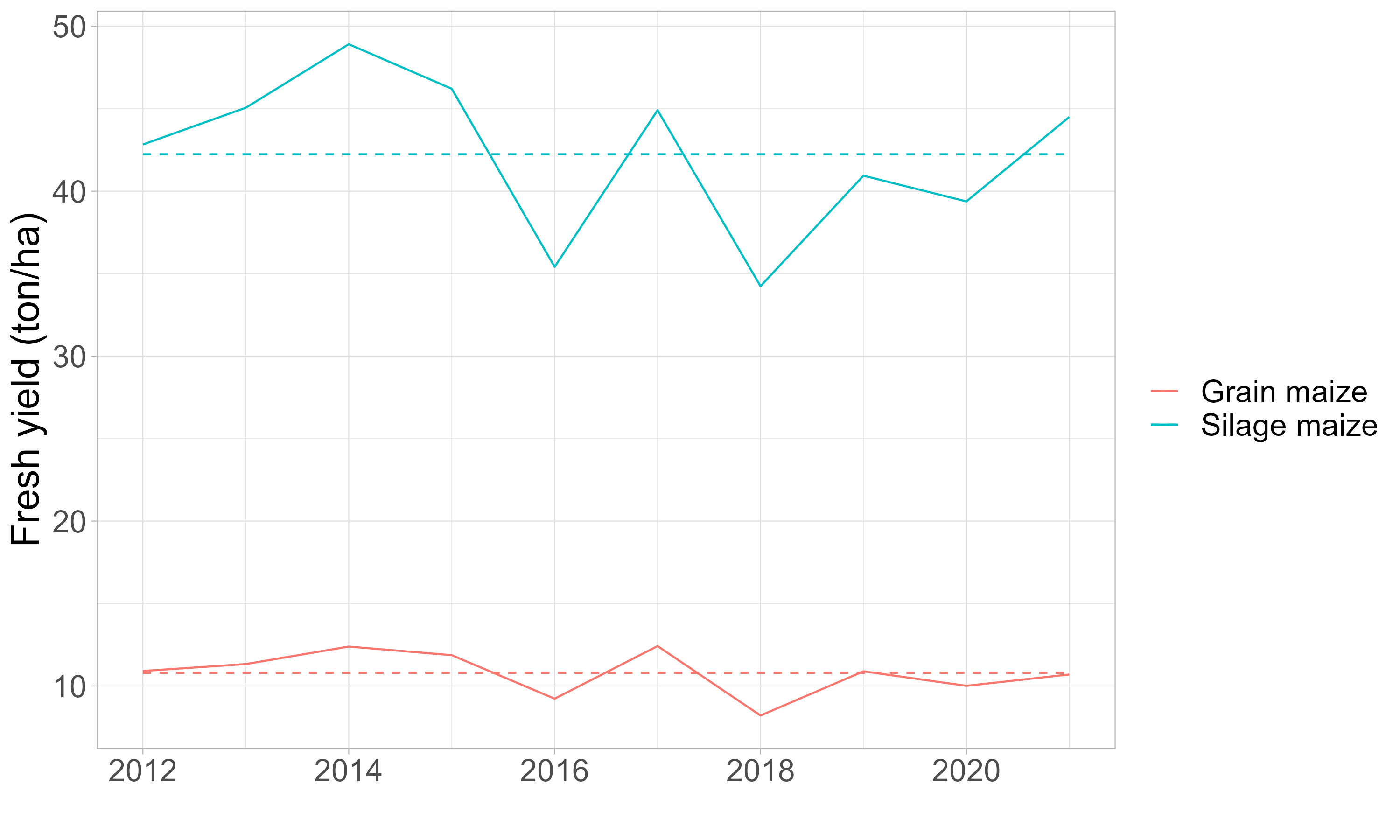
Figure 4:Fresh yield variation for grain maize and silage maize from 2012 to 2021 according to STATBEL. The average yield for that period is depicted in dashed lines.
Potato¶
Fresh tuber yield from irrigated fields ranges from 40 to 50 ton ha-1, but it can be lower in humid regions due to a higher risk of diseases Steduto et al., 2012. In Belgium, potatoes occupy only 5 % of the total farmland but it is a major crop of the country, with an average yield of about 43 ton ha-1 STATBEL, 2022. Therefore, there have been many efforts to increase potato production in the country. An example is WatchITgrow, which is a geo-information platform that helps to determine and improve potato yields in a sustainable way Swayer et al., 2019.
Potatoes are equally sensitive to too wet or too dry conditions due to their shallow rooting system, and cannot tolerate more than 24 hours of flooded conditions Swayer et al., 2019 because tubers are in direct contact with the soil and are more prone to rotting. Drought and heat stress during tuber formation were the dominant factors in 79 % of low-yielding years within the 1947 - 2012 period in Belgium Gobin, 2018. Nevertheless, waterlogging conditions played a major role in 49 % of the low-yielding years. The wet summer in 2021 in Belgium did not impact heavily the growing season of potato, evidenced by a yield slightly close to the 2012-2021 average according to STATBEL (2022) (Figure 5). However, the Agrometeorological Bulletin and Deronde (2021) reported that quality was lower due to severe disease stress caused by mildew, impossibility to apply phytosanitary treatments due to low trafficability, and growth cracks in the tubers in presence of high nitrogen concentration. In 2016, the persistent wet conditions during spring hampered the proper root development of the crop with an increased risk of water stress during the next dry months. These radical differences in weather conditions caused harvesting problems in the presence of hard mounts. Humid conditions also caused early flowering, and rotting in temporary flooded areas.
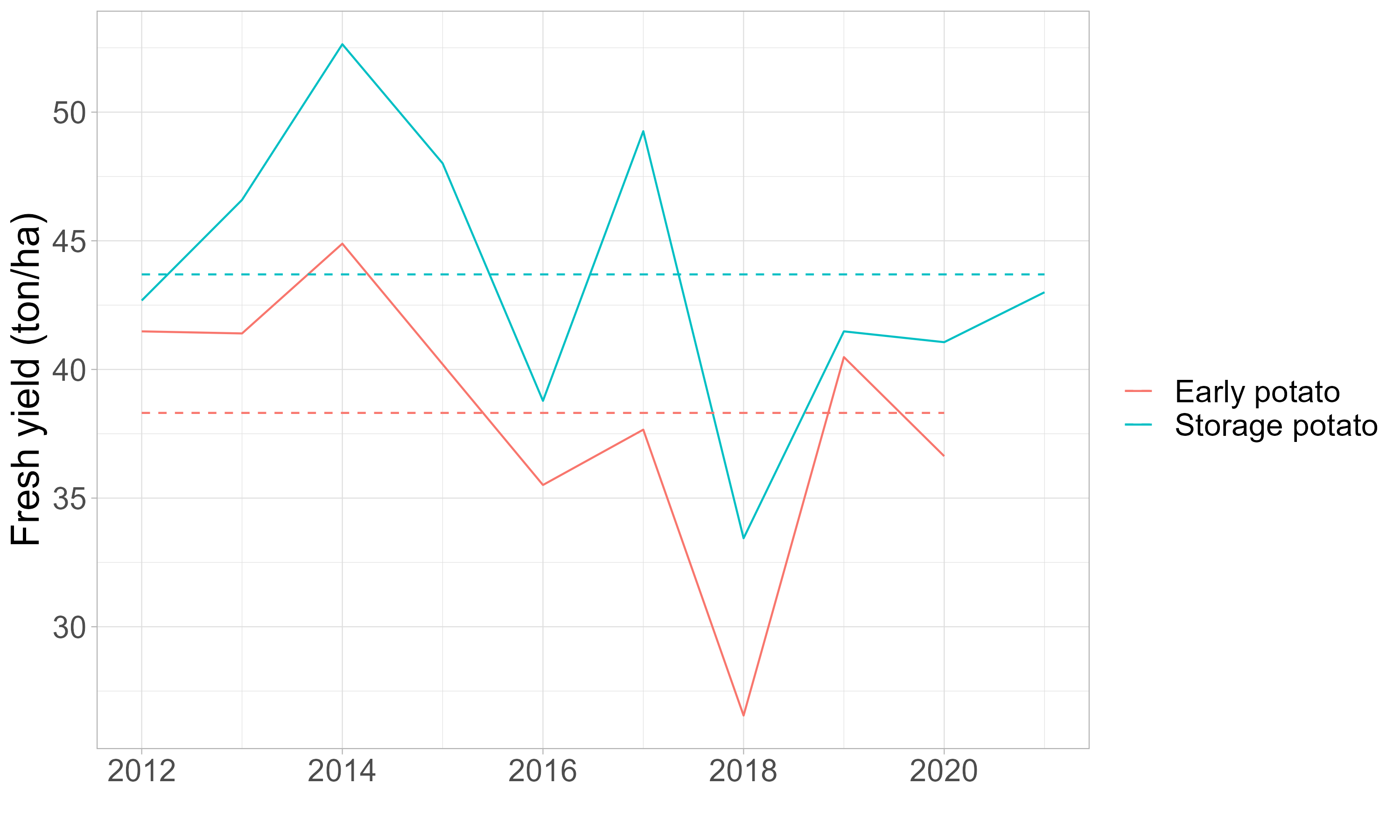
Figure 5:Potato fresh yield variation from 2012 to 2021 according to STATBEL. The average yield for that period is depicted in dashed lines.
Winter Wheat¶
Grain yield in rainfed temperate climate can vary from 4 to 10 ton ha-1, and can reach up to 15 ton ha-1 in cool environments with high solar radiation Steduto et al., 2012. In Belgium, the average yield is roughly 9 ton ha-1STATBEL, 2022. According to the weather risk analysis made by Gobin (2018) from the period 1947 to 2012 in Belgium, periods of waterlogging occurred mostly in spring, which together with low temperatures during the growing season, caused low yields during these years. Projected yield losses due to waterlogging are expected to be around 5 % based on Gobin (2010).
Waterlogging during the vegetative period can cause substantial yield reduction in winter wheat. Oxygen stress for just three days can already damage roots, leading to the displacement of stems (lodging), and reduction of the capacity of nutrient uptake, which decreases tiller numbers Steduto et al., 2012. Compared to other winter cereals, winter wheat has the capacity to develop physiological adaptations during transient waterlogging. Ploschuk et al. (2018) reported that winter wheat produced adventitious roots with 20 % of aerenchyma during 14-days of waterlogging, without reducing photosynthetic activity. However, the duration and time at which waterlogging occurs, influence the recovery capacity of the plant. Winter wheat was found to recover almost entirely under waterlogging of maximum 20 days during the early stage (before flowering) according to San Celedonio et al. (2017), while yield loss ranged from 34 % to 92 % if occurring in the flowering stage (Romina et al., 2014). Under prolonged waterlogging duration, roots can be severely damaged and the crop may not recover even if the water conditions improve Steduto et al., 2012.
Contrary to spring crops like maize and potatoes, the yield of winter wheat decreased by 8.5% in Belgium, in the wet summer of 2021 compared with the average, and by 22 % in 2016 STATBEL, 2022 (Figure 6). According to the reports in the Agrometeorological Bulletin, yield decrease in 2021 was mostly linked to lodging due to strong winds during the extreme rainfall events, harvesting delays and germination of grains. Similar occurred in 2016, where harvesting delays due to wet conditions caused plant to lodge.
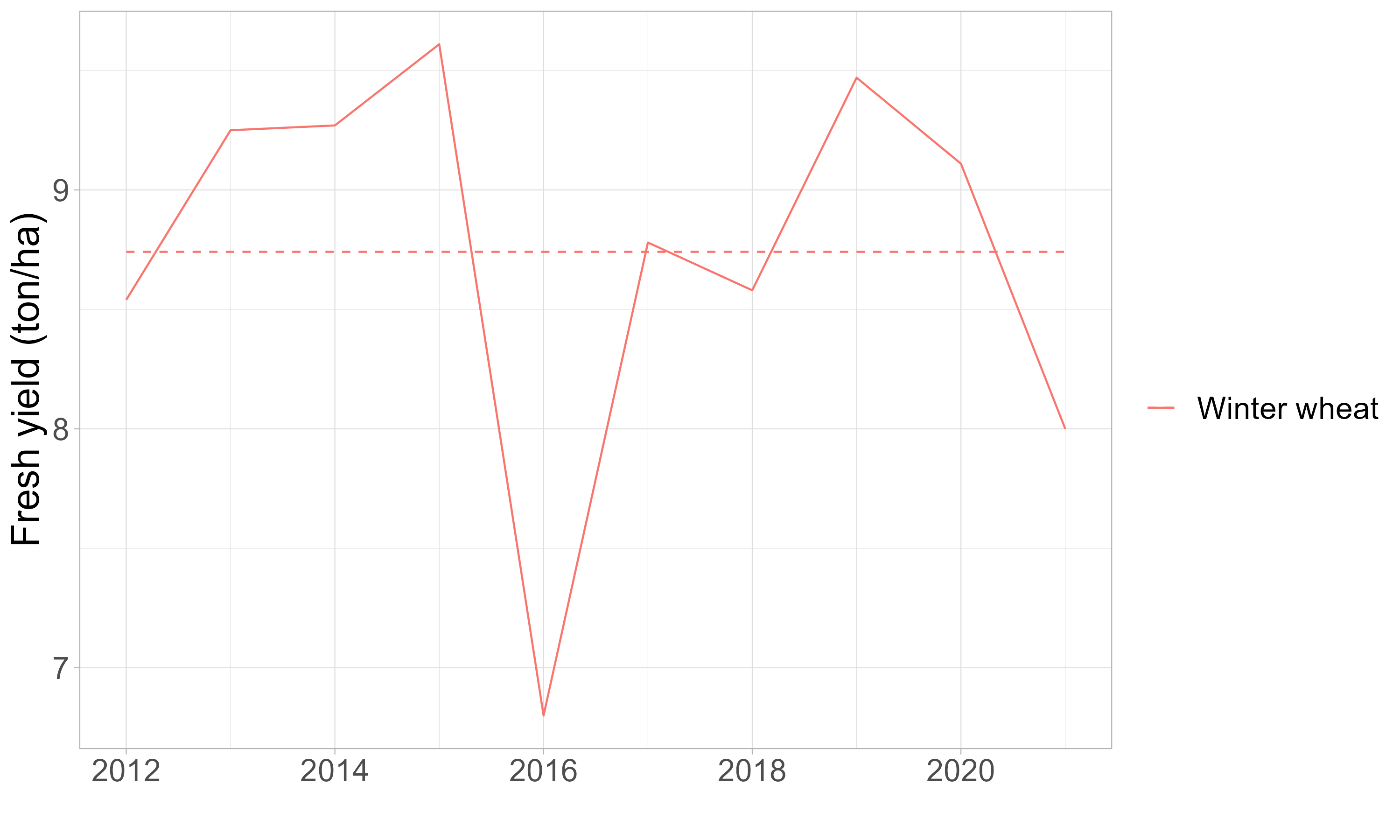
Figure 6:Winter wheat fresh yield variation from 2012 to 2021 according to STATBEL. The average yield for that period is depicted in dashed line.
Sugar beet¶
Fresh yield commonly ranges from 40 to 60 ton ha-1 but can go up to 100 ton ha-1 under optimal water and nutrient conditions Steduto et al., 2012. In Belgium, the average yield is about 85 ton ha-1 STATBEL, 2022. Sugar beet is very sensitive to water deficit in the initial growing stages. Its peak water requirement occurs at the end of the vegetation period when maximum canopy cover is reached. Early over-watering can inhibit leaf development and promote premature flowering and early production of seeds. Excess water (e.g. overirrigation) near harvest, increases fresh root yield but root sugar concentration may be reduced Steduto et al., 2012.
In Belgium, periods of repeated waterlogging explained 86 % of the low sugar beet yields during 1947 to 2012 Gobin, 2018. In contrast, projected yield losses were estimated to be around 12 % to 27 % due to droughts Gobin, 2010. Sugar beet is one of the few crops that has the possibility to recover partly from drought and heat due to their deep roots. This can be seen for example in the dry year of 2018, where the yield was similar to the average in contrast with other spring crops STATBEL, 2022 (Figure 7). In the wet summer of 2021, sugar beet also performed much better than other crops, the Agrometeorological Bulletin reported that despite some diseases like Pseudomonas, leaf development was very abundant and among the highest of the last decade. The heavy rains and the insufficient oxygen in the soil led to a pallidity of the foliage, but gradually restored at the end of the summer. However, the drastic weather changes in 2016 seemed to affect more the growing season of sugar beet, probably because disease pressure in the wet months and subsequent higher vulnerability to droughts.
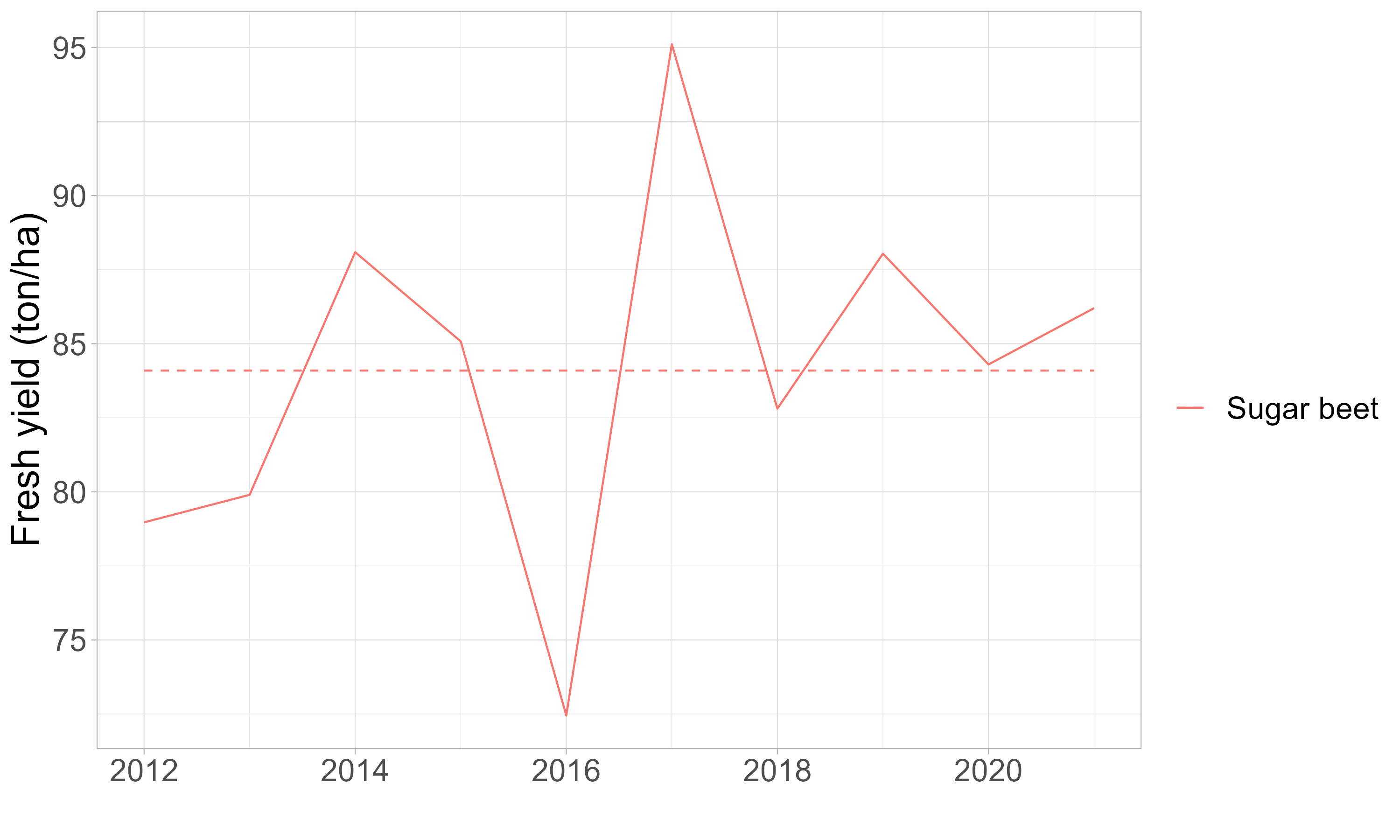
Figure 7:Sugar beet fresh yield variation from 2012 to 2021 according to STATBEL. The average yield for that period is depicted in dashed line
Indirect effects¶
Indirect crop damage due to excessive wet conditions are related to reduced trafficability and workability, soil degradation, sowing delays and retarded crop growth, pests and weeds. These factors ultimately lead to a reduction in crop yield. In Belgium, 79 % of low yields in maize during 1947 to 2012 were caused by late planting and delayed crop development due to a cold and wet spring, while waterlogging during harvesting explained 29 % of the low yields. In the case of potatoes, 43 % of the low yields were caused by waterlogging, which produced planting delays, tuber damage or difficult harvest operations Gobin, 2018.
Limited carrying capacity: trafficability, workability and trampling¶
Trafficability and workability refer to the capacity of the soil to support agricultural operations involving machinery, without causing structural damage Müller et al., 2011. Both qualities are essential for optimal planting, plowing and harvesting activities, and are largely limited by soil moisture conditions. Waterlogged soils can easily collapse by trampling through dispersion of clay particles, especially when concentration of sodium is high. Soil structure can be easily damaged in the presence of machinery or livestock McDonald, 2021. In grasslands, cows can damage the soil structure and increase soil compaction (trampling loss) leading to a reduced infiltration capacity or capillary rise, less oxygen available, and root growth restrictions Bakel & Hoving, 2017. The magnitude of the damage will depend on the carrying capacity of the soil, and can be reduced by using controlled traffic farming systems.
Knowledge of the type of crop can help to determine the required workability and trafficability, as this determines the weight of the machines used for planting/sowing and harvesting. In The Netherlands, heavier machines are commonly used for planting maize and potatoes while lighter machines are employed for winter wheat or sugar beet Bakel & Hoving, 2017. Machines used for harvesting are much heavier than the ones used in planting or sowing, which results in more soil compaction in wet conditions. Too wet conditions during the harvesting period are more severe because not all the field can be harvested or the next crop cannot be sown.
On the other hand, knowledge of the soil type allows to determine its mechanical behavior with changes in soil moisture content. Soil strength is highly dependent on soil water content and density, an this in turn determines the bearing capacity of the soil and energy required for tillage Müller et al., 2011. In cohesive soils, the soil strength as a function of water content can be described by the consistency index Ic (Figure 8), based on the upper plastic limit (UPL) and lower plastic limit (LPL). A value of 0.75 is commonly considered as a limit for workability but this is not necessarily a threshold for trafficability. Lower values denote that the soil is too wet and easily deformable (not good for trafficability), while higher values represent the soil is too dry and prone to fissures and crumbling (good for trafficability) Müller et al., 2011. In Figure 8, gravimetric water content ranges from 0.15 kg kg-1 to 0.50 kg kg-1 for Ic = 0.75. Soils with lower clay content change their mechanical behavior faster with variations in water content.
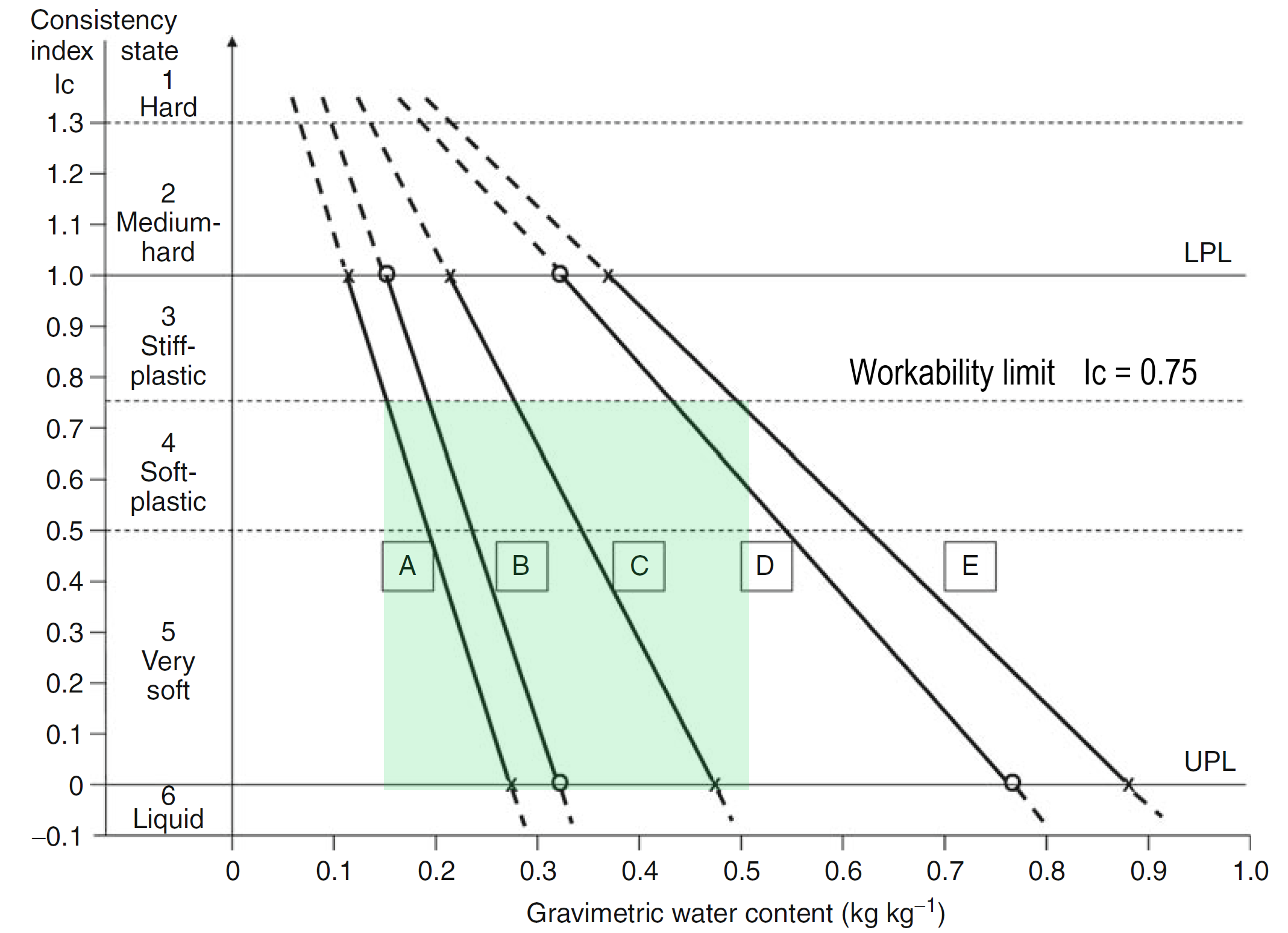
Figure 8:Consistency diagram based on lower plastic limit (LPL) and upper plastic limit (UPL) for five typical topsoil substrates in north-eastern Germany. Soils A, B, C, D and E have 15%, 20%, 30%, 40% and 50% clay content, respectively. Adapted from Müller et al. (2011)
Since the strength of the soil changes with soil water content, water table depth defines the trafficability and workability in a field. In turn, optimal water tables vary with soil type and climatic conditions. A water table depth lower than 75 cm may be adequate in heavy marsh soils in spring. In peatlands, water tables are commonly high and the soil bearing capacity is low under standard agricultural machinery. The choice of lighter machines can allow the trafficability and workability of these soils Müller et al., 2011.
Sowing or harvesting delay¶
Soil temperature and moisture content are the dominant environmental factors that determine crop germination. Crops need a certain soil temperature to germinate, which varies highly between species and even within cultivars. For example, maize requires at least 10 °C, which normally occurs in the last week of April, while winter wheat can germinate at lower temperatures of around 5 °C Singh & Dhaliwal, 1972. Wet soils warm up at a slower rate than dry soils in spring, and take longer to cool down in autumn due to the large heat capacity of the water Bakel & Hoving, 2017.
All crops are generally more susceptible to wet conditions during the germination and pre-emergency periods Moore et al., 1998. The greater the probability of wet conditions in autumn, the higher the chance of choosing early varieties that yield less. Also, if waterlogging occurs in spring, the sowing date will be delayed and the growing season will be shorter Van Oort et al., 2012. Therefore, soil moisture content, affecting both soil temperature and the carrying capacity, is one of the factors that determine the start of the growing season. On the other hand, harvesting delay due to limited carrying capacity cause the next crop planting to be postponed or even cancelled.
In The Netherlands, the largest negative yield anomalies in potato in the period 1951 - 2010 were explained by either a wet start of the growing season or a wet end of the growing season. Most of the low yields were due to late planting, especially when the date exceeded April, 30th Van Oort et al., 2012.
Soil quality, nutrient deficiencies and toxicities¶
The rate of oxygen depletion depends mainly on soil temperature but also organic matter, salinity and pH, and plant factors like growing stage, nutrients and adaptation ability Moore et al., 1998. With limiting oxygen, micro-organisms in the soil can compete with plant roots for the available oxygen or hinder the availability and uptake of certain nutrients. Consequently, microbial activity is among the factors determining oxygen stress to plant roots Bartholomeus et al., 2008.
Nitrogen can be lost from the soil through different paths, either via leaching or via chemical processes. Oxygen deficiency in the soil promotes the breakdown of nitrate (denitrification), possibly resulting in less nitrogen available. Waterlogging usually increases nitrogen leaching beyond the root zone, which can also contribute to nitrogen deficiencies Irmak & Rathje, 2008. Changes in redox potential, soil pH and soil temperature ultimately affect nitrogen transformation and availability Kaur et al., 2020. It may be required to add nitrogen in the soil to compensate for these losses. However, severely damaged crops may no longer recover and the addition of nitrogen is not profitable.
On the other hand, decreasing oxygen changes the physico-chemical properties of the soil (Figure 9). The reduction potential of the soil increases under waterlogged conditions and changes the chemical equilibrium of elements, which enter the soil-water solution in their ionic forms. This is the case of iron and manganese compounds, which can rise to toxic levels under anoxic conditions McDonald, 2021. Toxins can accumulate in the soil and anaerobic respiration can produce potentially harmful end products like ethanol. Soil pH is also reduced by the accumulation of volatile organic acids and the high concentration of CO2. These processes cause restricted root growth, because roots are less capable to extract nutrients from the soil and remain close to the surface where there is more oxygen Moore et al., 1998. Overall crop growth is compromised due to reduced tillering capacity, and premature leaf senescence and sterile florets Manik et al., 2019.
More detailed information about the chemistry in saturated or waterlogged soils are explained in the next chapter Impact of changing groundwater level on nutrient mobility.
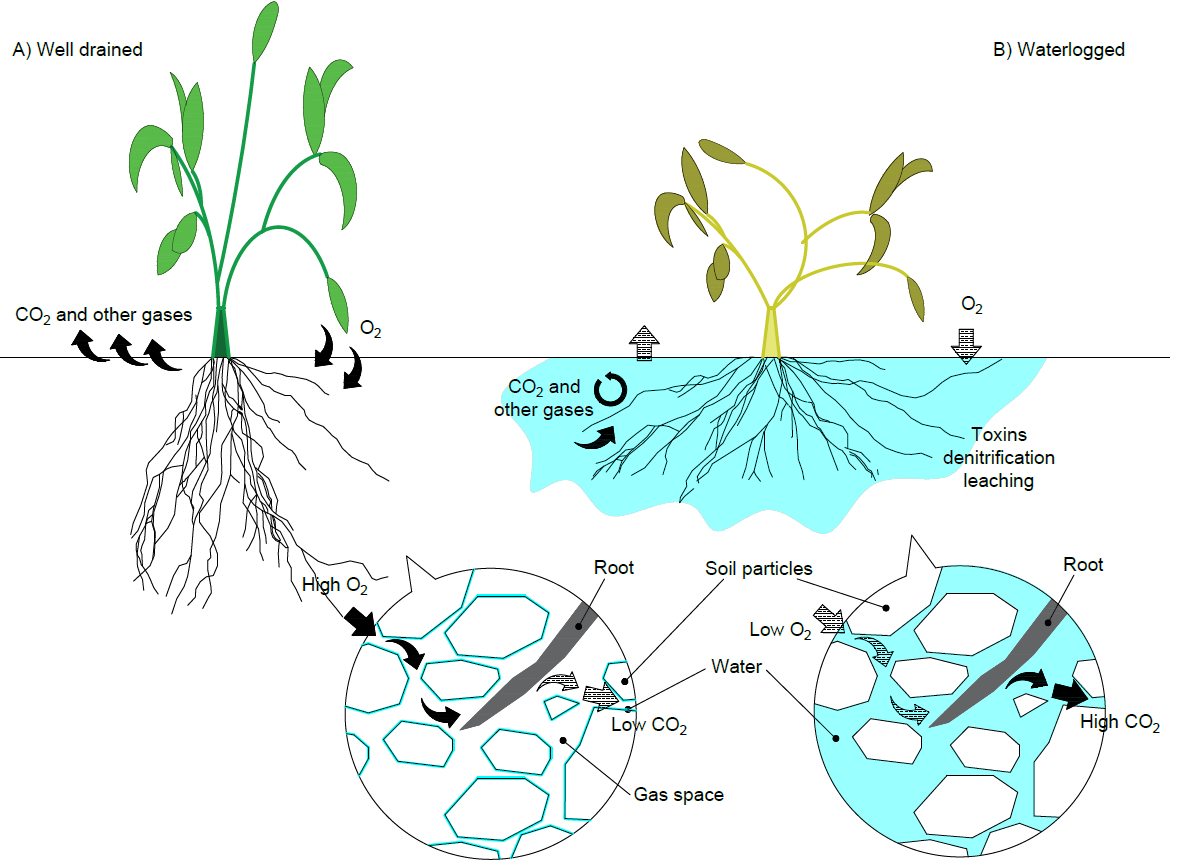
Figure 9:Diffusion of gasses in well drained soils and waterlogged soils. Adapted from Moore et al., 1998
Weeds¶
Weeds are unwanted plants, highly tolerant to abiotic stress, that interfere with crops and livestock production. They emerge and develop spontaneously when they find a suitable environment. Agricultural weeds compete for resources (light, nutrients, and soil moisture), can physically hinder and inhibit crop growth, host pests and promote diseases Schonbeck, 2022. Weeds can cause more crop losses than other biotic factors (animal pests and pathogens); estimates of the potential losses worldwide were on average 33 %, with the highest potential loss in maize (40 %) OERKE, 2005. More recent estimates of crop yield losses were about 28 % Vilà et al., 2021.
Wet conditions can cause an increase of diseases and pests, and can stimulate weed growth. Other plant varieties, more adapted to wet conditions and usually less valued, can take over and reduce crop production. The presence of plants like toad rush (Juncus bufonious), docks (Rumex spp.) and sedges (Carex) are common in waterlogged conditions Moore et al., 1998. Many grass species such as Lolium, Brachiaria and Phalaris, considered weeds in arable crops, can tolerate temporary waterlogging better than agricultural crops because they have genes usually found in aquatic plants Krähmer, 2016. This characteristic enables grasses to develop root adaptations that allow them to survive under wet conditions. Weeds may thrive around stressed crops since they have to compete less for nutrients and space.
Pests and diseases¶
Animal pests include insects, mites, slugs/snails, birds and mammals. Diseases comprise fungi, chromista, bacteria and viruses OERKE, 2005. Wet conditions and high temperatures favor the development of diseases on crops caused by fungus-like organisms. Diseases caused by Phytium, Phytophthora and Alternaria are common in wet weather conditions. These pathogens are usually present in many soils but become harmful in excessively wet conditions IPM, 2017. Certain insects such as the European crane fly (Tipula paludosa) and the fly pest fungus gnats (Bradysia and Lycoriella spp.) are attracted by moist conditions Weiland, 2012. Animal pests and diseases are known to cause a potential crop loss of about 19 % and 13 %, respectively OERKE, 2005.
Roots and seeds are more susceptible to diseases. Affected plants exhibit a shallow root system, root rot, damping-off, and yellowish or purple appearance of the plant Folnović, 2014. Pythium and Phytophthora species produce spores that easily move in water in saturated soils to infect new plants. The Pythium fungus is known to cause root rot in winter wheat when excessive soil moisture conditions are present, as the plant is more vulnerable in the first weeks after emergence. Another disease in flooded conditions is *Peronospora sparsa *(downy mildew), which can affect submerged wheat leaves Byamukama & Ali, 2022.
Deronde (2021) reported that the permanent high humidity and moderate temperatures in summer 2021 lead to severe disease stress in potatoes in Flanders, Phytophthora and Alternaria were widely observed in potato fields. The Agrometeorological Bulletin also recorded different bacterial and fungal diseases in crops such us Pseudomona, Cercospora beticola, Rhizoctonia solani, and Erwinia.
Crop damage and harvest quality¶
Excess water causes rotting of harvestable products, especially in arable crops like potatoes, where the tubers are in direct contact with the soil. In the case of grass, it restricts grazing for a certain period of time Bakel & Hoving, 2017
According to a newspaper article published in August, 2021 Times (2021), the quality of the harvest of different fruits, grains and vegetables was reduced due to a humid spring and constant rainfall events in summer 2021. Wet conditions led to indirect effects like poor pollination of the flowers especially in pears or scab formation in apples, which makes it difficult to meet quality standards. Besides this, long wet periods followed by dry periods enhanced secondary tuber formation alongside the main tuber, which modify the size and the shape of the potatoes and look less appealing for customers. Deronde (2021) pointed out that the large amount of precipitation, often in combination with high nitrogen content in 2021 caused a disproportionate tuber growth resulting in growth cracks and hollowness, mainly in the cultivar Fontane. Some Fontane plots also showed new flowering and tuber growth leading to green tubers during harvest.
In grasses, the content of protein and fiber define the quality. The crude protein content, which is more efficiently assimilated for meat and milk production, should be least 7 % to meet the animal requirements. The fiber content, although fundamental for stimulating the rumen function, should be lower than 35 % for acidic detergent fiber (ADF) and smaller than 50 % for Neutral Detergent fiber (NDF), in order to have good digestibility levels Oregon State University, 2018. With maturity, protein decreases and fiber increases. Consequently, the optimal harvesting time depends on the desired quality and quantity. Early-harvested grass will be more protein-rich than a late-harvested grass, but with a lower biomass volume. Harvesting time is affected by weather and soil conditions: the soil needs to be dry enough for the machines to enter the field or for the cattle to graze Oregon State University, 2018. Therefore, a harvesting delay due to high soil moisture conditions will compromise the quality of the grass and the possibility to storage it.
- Zipper, S. C., Soylu, M. E., Booth, E. G., & Loheide II, S. P. (2015). Untangling the effects of shallow groundwater and soil texture as drivers of subfield-scale yield variability. Water Resources Research, 51(8), 6338–6358. 10.1002/2015WR017522
- Liu, Z., Chen, H., Huo, Z., Wang, F., & Shock, C. C. (2016). Analysis of the contribution of groundwater to evapotranspiration in an arid irrigation district with shallow water table. Agricultural Water Management, 171, 131–141. 10.1016/j.agwat.2016.04.002
- Wu, Y., Liu, T., Paredes, P., Duan, L., & Pereira, L. S. (2015). Water use by a groundwater dependent maize in a semi-arid region of Inner Mongolia: Evapotranspiration partitioning and capillary rise. Agricultural Water Management, 152, 222–232. 10.1016/j.agwat.2015.01.016
- Rasmussen, C. R., Thorup-Kristensen, K., & Dresbøll, D. B. (2020). Uptake of subsoil water below 2 m fails to alleviate drought response in deep-rooted Chicory (Cichorium intybus L.). Plant and Soil, 446(1), 275–290. 10.1007/s11104-019-04349-7
- Bartholomeus, R. P., Witte, J.-P. M., van Bodegom, P. M., van Dam, J. C., & Aerts, R. (2008). Critical soil conditions for oxygen stress to plant roots: Substituting the Feddes-function by a process-based model. Journal of Hydrology, 360(1–4), 147–165. 10.1016/j.jhydrol.2008.07.029